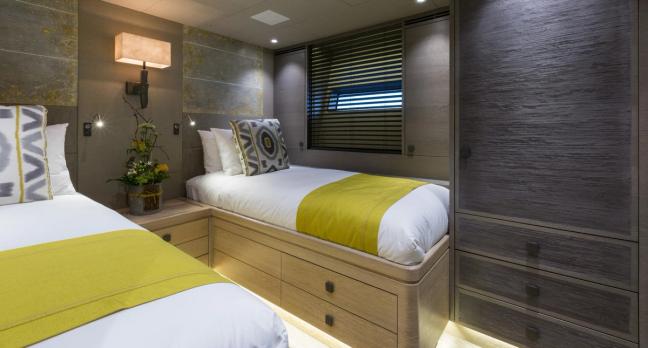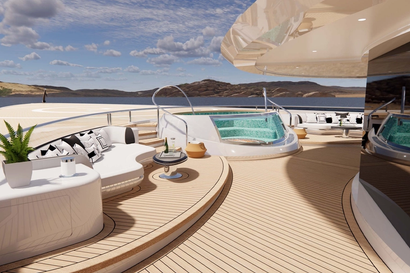When the motor Yacht A launched in 2008 – built for Russian billionaire Andrey Melnichenko – she turned the rarefied world of superyachting on its head. Among a sea of traditionally styled craft, this cutting-edge vessel was conceived to make a statement – and make a statement she did. Even now, some eight years on, she stands alone as a love-her-or-hate-her masterpiece of individuality thanks to her extreme styling by famed designer Philippe Starck. Starck continues to make his mark: take his vision for Steve Jobs’ iPhone-like yacht Venus with its highly innovative glass exterior (sadly completed after Jobs’ death) and his work on Melnichenko’s 143m Sailing Yacht A.
But these individual flights of fancy remain a rarity that are more statement pieces for owners who care little about resale values or charter potential – two elements that remain king in the eyes of many potential buyers, who reason that convention and a neutral palette are essential to preserve the considerable investment of personal funds.

However, a new breed of ultra-high net worths who approach superyachting without the background of boating tradition are underpinning a quiet revolution in interior design. They are adding a personal touch to their yachts by employing designers who have developed their reputations in land-based projects and who are prepared to question what can and can’t – or should and shouldn’t – be done on a yacht.
One such person is Maria Speake, co-founder of architectural salvage and design company Retrouvius, who was approached by a client to help re-imagine a 35-year-old, 60.5m yacht in an extensive – and expensive – refit. It would become her first yacht project. ‘You need an understanding of how a yacht is going to be used and how you make people comfortable,’ she begins. ‘There’s far too much hierarchy and snobbery associated with boats that can actually make visitors feel uncomfortable. Owners want to be able to play on their terms, and most people don’t like lots of staff or crew faffing about around them.’
A new breed of ultra-high net worths are underpinning a quiet revolution in interior design
The yacht in question would be renamed Kingdom Come, and key to her makeover was the brief. ‘The client was a brilliant brief-setter,’ Speake enthuses. ‘The ideas he wanted to explore were great – very good abstract ideas that allowed us to work with both the potential of the boat and the fun of the people who were going to be using it.

Inukshuk
A certain element of the tone was set almost before we’d even started designing – there had been a brilliant auction at Christie’s of out-of-the-ordinary objects, and the client had got carried away and bought all sorts of marvellous things. They all fed into this idea to create a sort of floating country house with varied rooms and layers of stories.’
The result is quite extraordinary. Building on the significant history of the yacht and its previous owners, Speake peeled away the interior to remove the excesses but preserve the yacht’s narrative, while adding the client’s own patina and personalisation to create a luxurious yet informal, fun environment. ‘It’s more like a pied-à-terre than a floating hotel,’ she explains. ‘So for example we have one great fun drawing room that we call The Opium Den, and we got that name because it was designed around the idea of creating a mood that is elegant and louche, but not too louche.
To achieve that, I found this amazing 19th-century cut Japanese antique velvet panel. Then we have the Dirty Diner, a kitchen-cum-dining room finished in reclaimed teak, with mirrored panels that came from the Unilever building and a fantastic huge enamel sign from an American drug store that says “drugs”. Plus, what had been the officer’s mess became this nice shared diner space for informal eating, where kids can get ketchup everywhere and no one will feel precious about it.’

Speake brought her salvage skills to bear not only in the addition of new and interesting materials but also in preserving and repurposing some of the fixtures and stones that were part of the older décor of the yacht. ‘I think, “How can I keep what’s special or fabulous about something that’s there, or work out a way to re-use it, as well as bringing new or reclaimed materials on board,”’ she says.
Building on the significant history of the yacht and its previous owners, Speake peeled away the interior to remove the excesses but preserve the yacht’s narrative
‘Everything on the boat has a story and you’re just adding another layer to the tale. There was very much an element of being able to strip back and look at what was amazing about the boat, and what needed to be kept as part of the original features. You blur the boundary between what you have and haven’t done with it.’
As a result, Kingdom Come offers individuality and an inviting informality that many yachts so sadly lack. Throughout the boat, the furniture is designed to be used and interacted with, not merely admired from afar. Furthermore, Speake has tackled the acres of veneer and paint, the rounded edges, the built-in wardrobes and the status quo. ‘I met some naval architects because, as it was my first boat, I didn’t know anything about it, and they started talking about the beds typically used on boats, which are called coffin beds,’ she laughs. ‘Why would anyone want to sleep in a bed called a coffin bed – that’s miserable!’

‘I grew up in the industry when interiors were designed by naval architects who thought they should resemble a boat’s,’ says Adam Lay, founder of Adam Lay Studio and designer of several unique superyacht interiors. ‘But clients now often want something unusual.’ One of Lay’s recent projects – a large sailing yacht named Inukshuk – is typical, with an interior that uses shapes, colours and themes inspired by the indigenous culture of the owner’s favourite cruising ground. It extends to incorporating art and mementos. ‘We often supply art or we guide the owner on what will work, but we also sometimes design spaces for the owner’s own collection,’ Lay continues.
It suggests individuality now rules over commercial return, and that aesthetics and personal taste – whether in décor or art – are taking centre stage on yachts that are not aiming to appeal to a wider charter market. ‘There has been a lack of personalisation in recent years,’ says Lay. ‘But we are being pushed more now because of general design, where form following function gets blurred and where looks over functionality rule the day.’

It hasn’t – yet – become a universal trend though, not least because many owners or potential owners are still wary of limiting the appeal to potential future buyers who may not share their particular tastes. ‘It’s a real split,’ Lay says. ‘But the industry has come back to where it was 20 years ago, and clients are building yachts for long-term ownership rather than just looking to flip them. We’re finding that more clients want to be deeply involved in the project and are looking for something amazing.’
For Speake, though, the biggest challenge facing yacht interior styling is that for a large part it remains rooted in the conservative traditions of the yachting industry – something she was keen to challenge with Kingdom Come. ‘Everything that I kept being told I shouldn’t do on a boat, I was saying “Why not?” It doesn’t make any sense to me,’ she concludes. ‘I’ve been involved with people’s houses for a long time, and I’ve observed just how much design in that field has changed. I think it’s no different for yachts – they are just floating houses, really.’

Become a Gentleman’s Journal Member?
Like the Gentleman’s Journal? Why not join the Clubhouse, a special kind of private club where members receive offers and experiences from hand-picked, premium brands. You will also receive invites to exclusive events, the quarterly print magazine delivered directly to your door and your own membership card.


